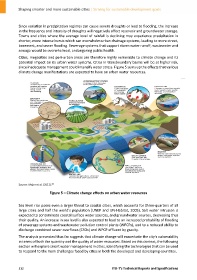Page 522 - Shaping smarter and more sustainable cities - Striving for sustainable development goals
P. 522
Since variation in precipitation regimes can cause severe droughts or lead to flooding, the increase
in the frequency and intensity of droughts will negatively affect reservoir and groundwater storage.
Towns and cities where the average level of rainfall is declining may experience precipitation in
shorter, more intense bursts which can overwhelm urban drainage systems, leading to more street,
basement, and sewer flooding. Sewerage systems that support storm water runoff, wastewater and
sewage would be overwhelmed, endangering public health.
Cities, megacities and peri‐urban areas are therefore highly vulnerable to climate change and its
potential impact on its urban water systems. Cities in transboundary basins will be at higher risk,
since inadequate management could intensify water stress. Figure 5 sums up the effects that various
climate change manifestations are expected to have on urban water resources.
22
Source: Major et al. (2011).
Figure 5 – Climate change effects on urban water resources
Sea level rise poses even a larger threat to coastal cities, which accounts for three‐quarters of all
large cities and half the world's population (UNEP and UN‐Habitat, 2005). Salt water intrusion is
expected to contaminate coastal surface water sources, and groundwater sources, decreasing thus
their quality. An increase in sea level is also expected to lead to an increased probability of flooding
of sewerage systems and wastewater pollution control plants (WPCPs), and to a reduced ability to
discharge combined sewer overflows (CSOs) and WPCP effluent by gravity.
The analysis presented thus far suggests that climate change will exacerbate the city's vulnerability
in terms of both the quantity and the quality of water resources. Based on this context, the following
section will explore smart water management in cities, identifying the technologies that can be used
to respond to the main challenges faced by cities in both the developed and developing countries.
512 ITU‐T's Technical Reports and Specifications

